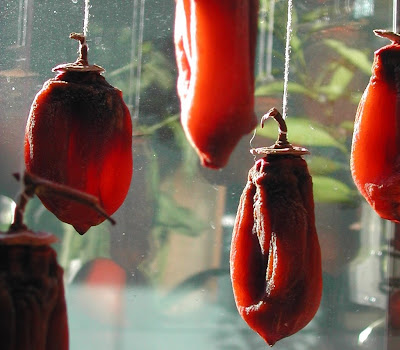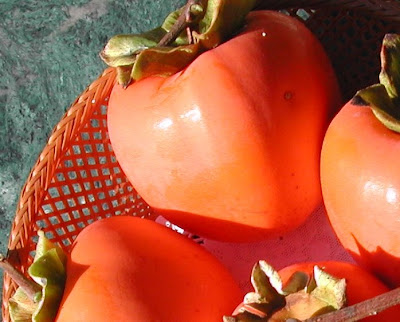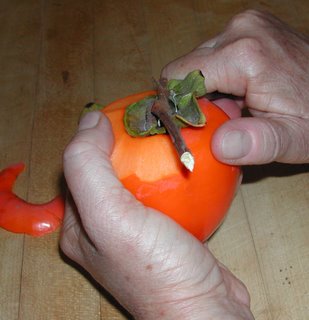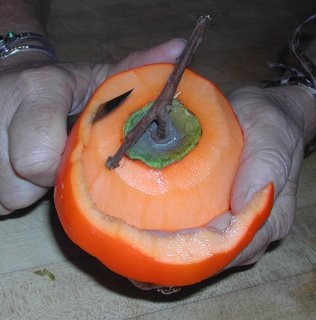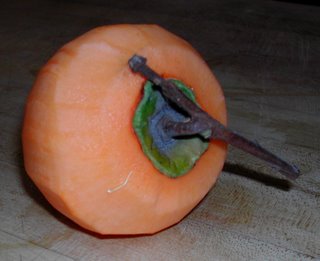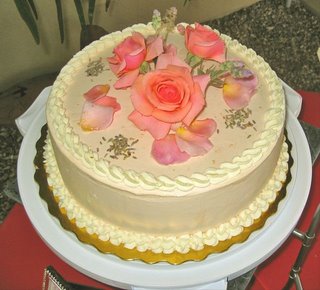Hoshi Gaki
Notice one is enclosed in a cheesecloth sling. The stem came off that one. The cheesecloth has worked just fine.
You hang them in groups of two, looping a doubled string over the stems. Arrange them so one hangs higher than the other and place them next to each other alternating high and low.
Usually you hang them from a bamboo pole, but I decided my garden window would work just fine.
I can open the windows on either side to get a little cross ventilation to help them dry.

This is after the first day of hanging. The outer flesh is beginning to look a little papery and not so taut.
It’s supposed to take about 3 to 4 weeks of massage every two or three days. Mine are moving along a lot faster. It may be because they are in the window.
I haven’t taken any pictures lately because I’ve been so busy trying to keep them all massaged. We probably have 50 hanging in the kitchen right now.
Yesterday we tasted one that had reached the stage of rich candy-like sweetness, moist but not gooshy. It was incredible. Dave tasted one today and decided to hang another rack so we can make a lot more.
A sugary bloom begins to collect on the outside as they get to this luscious dried state.
A Tree Full of Persimmons
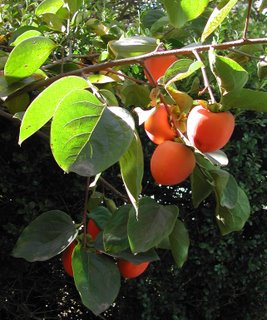 It’s that time of year in So. California when the Persimmon trees are laden with fruit and you realize you only need a couple of persimmon puddings for the holidays, so what the heck are you going to do with all those persimmons.
It’s that time of year in So. California when the Persimmon trees are laden with fruit and you realize you only need a couple of persimmon puddings for the holidays, so what the heck are you going to do with all those persimmons.
I’ve tried freezing them whole like billiard balls (in case I need a batch of persimmon bread or cookies during the year), but I already have a freezer filled with persimmon balls and no room for anything else. So when I heard about a persimmon massage class that our local Slow Food group was giving, I decided that might be the solution.
Apparently massaged persimmons yield luscious dried fruit far superior to other dried forms and in Japan when Hoshi Gaki (the massaged fruit) is given as a gift at New Years, it’s considered a special treasure and is said to bring good luck. So here’s a lovely way to distribute excess fruit to your friends at the end of the holidays.
First you pick firm persimmons leaving the stem attached to the fruit. In fact, in Japan, they usually break off part of the branch that the stem is attached to, so you get a little “t” at the top.
You’ll need a small paring knife to remove the top, leaving the stem and part of the calyx.
If you rest the tip of the knife against the front side of the stem and then rotate the persimmon as you cut, you should get a nice flat top.
“Should” is the operative word here. but with a little practice they’ll be flat and the ones that aren’t smooth are still going to be delicious.
The next step is to hold your knife at a 45 degree angle and peel around the top edge to make a shoulder on the fruit.
I’m not sure why this is important but it gives the fruit a nice artistic look and in Japanese culture that is usually reason enough.
At this point you can use your peeler to remove the rest of the skin.
Peel lightly and only peel over the tip once. Any thin places run the risk of breaking before the inner pulp is dried and allowing it to leak out.
The outside will become sort of leathery and will form a bag to hold the moister interior as you massage it. The purpose of the massage is to move the moisture around to help the persimmon dry evenly.
This persimmon is peeled and ready to hang. But since I have 30 bries to deliver this morning, you’re going to have to wait for the next blog update to see how to line them up for massage.
In the meantime, you can go to Jeff Reiger’s Hoshi Gaki page at Penryn Orchard Specialties. Jeff was our teacher at the Slow Food class and he sells a variety of persimmons as well as his own hoshi gaki.
Pistachios 101
 These are the green nuts picked right from the tree. They have a fruity hull that turns black if not removed soon after picking.
These are the green nuts picked right from the tree. They have a fruity hull that turns black if not removed soon after picking.
We sold green nuts at the Farmer’s Market. Most Americans are not familiar with green nuts because the nuts don’t keep well in this stage. SB Pistachio Company only sells green nuts at the Farmer’s Market and only during the harvest. They are picked the day before the market, sorted, and bagged by hand.
You must remove the soft hull to find the hard-shelled moist nut inside. In Iran, they boil the husks to make a jam. I talked with a woman at the Santa Monica Farmer’s Market who told me her mom made jams from the hulls, but she never learned the recipe from her mom.
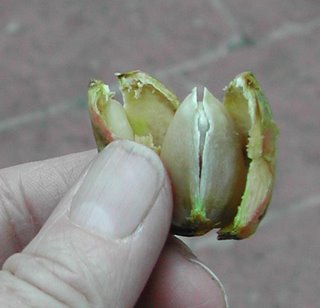 This pistachio has opened naturally on the tree. That means it is fully developed. The raw (undried) pistachio tastes fruity and a little citrusy. The texture is more fruitlike. It doesn’t have the crunch of a dried pistachio.
This pistachio has opened naturally on the tree. That means it is fully developed. The raw (undried) pistachio tastes fruity and a little citrusy. The texture is more fruitlike. It doesn’t have the crunch of a dried pistachio.
At the processor, the husks are removed. Open ended pistachios are sorted from closed-shell pistachios. Closed-shell pistachios are shelled and sold as kernels. This harvest brought in 80% open ended nuts.
Remember when we used to buy pistachios in red or green shells? They were dyed to mask the stains left from hulls that weren’t removed quickly enough. Hmm, I think I probably ingested a lot of red dye using my teeth to pry open red pistachios.
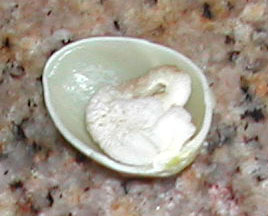 Here is a freshly picked pistachio that didn’t develop. I’m guessing that’s because pollen from the male tree didn’t reach this flower. A lot of the nuts that don’t shake off the tree easily contain these undeveloped pistachios that look a bit like embryos. The shells on these are tightly closed. But some of the closed-shell pistachios do contain fully developed kernels.
Here is a freshly picked pistachio that didn’t develop. I’m guessing that’s because pollen from the male tree didn’t reach this flower. A lot of the nuts that don’t shake off the tree easily contain these undeveloped pistachios that look a bit like embryos. The shells on these are tightly closed. But some of the closed-shell pistachios do contain fully developed kernels.
Closed-shell pistachios are put into a water bath to separate the heavier “sinkers” containing fully developed kernels from the “floaters,” which aren’t worth cracking open.
The Pistachio Shake Down
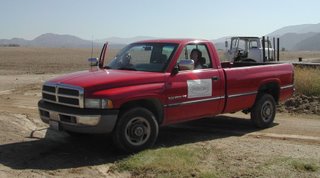 Gail and Gene Zannon own 380 acres of pistachio trees in Cuyama, California. Since I’m doing marketing writing for their pistachio company, they invited Dave and me to come see the harvest. The harvest lasts two weeks out of the year. we arrived on the first day. Gail drove us out to to watch.
Gail and Gene Zannon own 380 acres of pistachio trees in Cuyama, California. Since I’m doing marketing writing for their pistachio company, they invited Dave and me to come see the harvest. The harvest lasts two weeks out of the year. we arrived on the first day. Gail drove us out to to watch.
 Here are the clusters of pistachios ready for harvesting. All of the orchards are in transition to organic. This one, however, is fully organic and will be their first certified organic crop. Everyone was especially excited to see the pistachios coming off these trees.
Here are the clusters of pistachios ready for harvesting. All of the orchards are in transition to organic. This one, however, is fully organic and will be their first certified organic crop. Everyone was especially excited to see the pistachios coming off these trees.
Cuyama is well adapted to organic pistachios because the short hot growing season eliminates the aflatoxin problem that many other orchards are fighting and the cold winters naturally reduce the pests.
 It takes 5 seconds to harvest a tree. A mechanical shaker encircles the trunk of the tree, giving the tree a fast sturdy shaking. Ripe pistachios fall into a collector and the driver moves on to the next tree.
It takes 5 seconds to harvest a tree. A mechanical shaker encircles the trunk of the tree, giving the tree a fast sturdy shaking. Ripe pistachios fall into a collector and the driver moves on to the next tree.
We followed the harvester and picked up nuts left on the ground which we husked, shelled and ate as we walked. We could feel the ground vibrate as the trees were shaken.
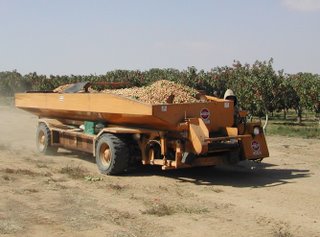 Here is a collector filled with freshly harvested nuts. These nuts are rushed to the processing plant to be husked, dried, and sorted. If they are not husked within 24 hours, the husks will turn brown and stain the inner shells.
Here is a collector filled with freshly harvested nuts. These nuts are rushed to the processing plant to be husked, dried, and sorted. If they are not husked within 24 hours, the husks will turn brown and stain the inner shells.
Gail’s sons Tristan and Josh took a short break for a photo with us. The boys manage the planting, care, and harvest of the trees. Harvest is an intensely busy but rewarding two weeks of the year for them.
Santa Barbara Pistachio Company
 So I’ve been talking a lot about pistachios lately. And anyone who has stopped by our house recently has probably tasted my pistachio clusters, pistachio macaroons, pistachio cranberry oatmeal cookies, or pistachio raspberry cake. Hmm, notice a common thread here?
So I’ve been talking a lot about pistachios lately. And anyone who has stopped by our house recently has probably tasted my pistachio clusters, pistachio macaroons, pistachio cranberry oatmeal cookies, or pistachio raspberry cake. Hmm, notice a common thread here?
I finally have the perfect job. I get to write about food AND bake up new recipes. I think this must be heaven.
Not all of you know that I didn’t actually go to France to take the professional baking program I’d signed up for. That’s the bad news. The good news is that I was here for the pistachio harvest in Cuyama (the northeast part of Santa Barbara County).
Dave and I drove to the Santa Barbara Pistachio farm in Cuyama last week. A beautiful trip out highway 33 past amazing geological rock formations and sedimentary deposits turned on their sides. (Next time I’ll take some pictures of those.)
We arrived at the store and found Gail back in the processing and shipping area behind the store.
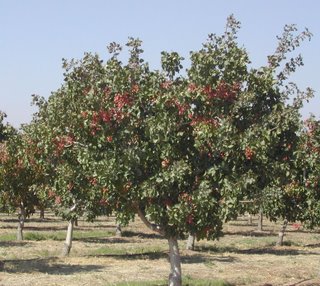 We’d guessed that we were getting close to the store when we started seeing these trees at the side of the road. Pistachios grow in red clusters on the female trees. Most of the trees in the orchard are female trees. These are young trees. It takes a tree about 1o years to develop and begin to produce a significant crop of pistachios.
We’d guessed that we were getting close to the store when we started seeing these trees at the side of the road. Pistachios grow in red clusters on the female trees. Most of the trees in the orchard are female trees. These are young trees. It takes a tree about 1o years to develop and begin to produce a significant crop of pistachios.
Pistachios originated in the high deserts of the Middle East. Iran is the world’s largest producer of pistachios, but California has also become a primary worldwide pistachio source. Cuyama’s growing conditions are quite similiar to the pistachio growing areas of Iran, Turkey, and Afghanistan.
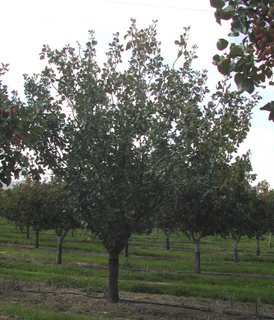
There are also male trees in the orchard, but not nearly as many. They produce the pollen to fertilize the female flowers but don’t produce any pistachios. Wind carries the pollen to the female trees and one male can pollinate a LOT of female trees. So occasionally you’ll see a slightly larger fruitless tree surrounded by many fruit-laden trees. We can draw many conclusions about nature from this, but we won’t.
 And here are the progeny. The pistachios hang down in clusters, like grapes. On the outside is a lovely red fruity husk. You peel that off and inside is the hard shelled nut we recognize as a pistachio. The trick is to try to leave the clusters on the trees long enough for most of the shells to crack open inside the husks (called open shell pistachios). Many pistachios are harvested earlier and then the ends are cracked open artifically. Those nuts aren’t as rich and delicious as tree-ripened nuts, but the farmers don’t risk loss from rain or wind which can cause the tree to drop its ripest nuts before the harvest.
And here are the progeny. The pistachios hang down in clusters, like grapes. On the outside is a lovely red fruity husk. You peel that off and inside is the hard shelled nut we recognize as a pistachio. The trick is to try to leave the clusters on the trees long enough for most of the shells to crack open inside the husks (called open shell pistachios). Many pistachios are harvested earlier and then the ends are cracked open artifically. Those nuts aren’t as rich and delicious as tree-ripened nuts, but the farmers don’t risk loss from rain or wind which can cause the tree to drop its ripest nuts before the harvest.
Fortuntely the weather held and resulting nuts were definitely worth taking the risk.
As if the World’s Best Lasagna Wasn’t Enough
Leslie said we needed a salad to go with the lasagna so Jane, another student, said she’d take care of the salad for us. Jane has a knack for taking whatever food is available in the kitchen and creating something extraordinary with it.
Carlos and I had a zestless orange leftover from the Honey Cake we were making for dessert. The leftover orange segments became a featured ingredient in Jane’s green salad. A search through the pantry also yielded some pumkin seeds, dried cranberries, and raspberry vinegar.
Jane plumped the cranberries with the orange segments by soaking them in a little marinade she whipped up and then went to the stove to pan-roast the pumpkin seeds to just the right flavor and crispness.
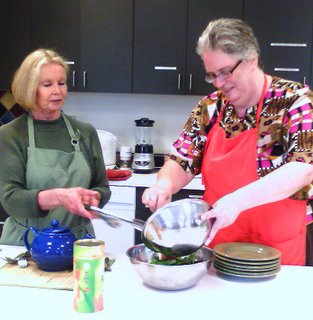 Here she is putting it all together.
Here she is putting it all together.
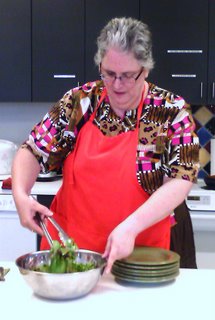 Salad anyone? While we ate Jane’s salad we talked about the flavors in the salad and laughed about the days when salad was a wedge of iceberg lettuce with a dollop of Thousand Island dressing on top.
Salad anyone? While we ate Jane’s salad we talked about the flavors in the salad and laughed about the days when salad was a wedge of iceberg lettuce with a dollop of Thousand Island dressing on top.
Oh, the Honey Cake? Well that was a learning experience. It browned too quickly in the 350 degree oven and then sunk in the middle, probably because I jiggled it putting foil over the top to slow the browning while the center baked. Even then, by the time the center was set, the outer edges were overcooked.
Carlos suggested that it would be better with less honey so that you could taste the more subtle orange zest, coffee, cinnamon, and clove flavors. He’s right. Less sugar would also keep it from carmelizing so quickly at the surface. And maybe baking it in a bundt pan or two loaf pans, rather than a square pan, would allow the heat to penetrate to the center more quickly. Of course that didn’t keep us from eating it!
Braille Cooking
I’ve been talking a lot lately about the cooking classes at the Braille Institute where I’ve been assisting. Our students are low- to no-vision adults. Many are older adults, but some are my age (the far end of middle-age) and some are younger adults. Leslie, the teacher, coordinates the all cooking classes and teaches history and bridge to students as well.
Yesterday Leslie asked one of our students to show us how she makes spinach lasagna. Fortuna is from Italy. Her spinach lasagna is the best. We started with a bouquet of fresh spinach, which Fortuna cleaned, stemmed, and put into boiling water to cook just long enough to wilt but not lose its brilliant green color and fresh flavor.
She drained the spinach and pressed out the excess water, then added ricotta, freshly grated Parmesan, grated mozzarella, and a little salt. Leslie had purchased sheets of fresh pasta from Via Maestra 42, a local Italian cafe. Fortuna covered the layers of tender fresh pasta with marinara sauce, the ricotta mixture, and more of the grated cheeses.
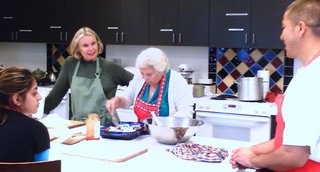
She topped it off with more sauce and cheese before we put it into a 350 degree oven to melt the cheeses, cook the pasta, and meld all those wonderful flavors.
 The recipe said it would take an hour, but Fortuna said it’s done when it begins to bubble. We were relieved to hear that because once the aroma began to escape from the oven we didn’t think we could wait a whole hour to taste it. We also noticed that a lot of people started dropping into the classroom to see how things were going.
The recipe said it would take an hour, but Fortuna said it’s done when it begins to bubble. We were relieved to hear that because once the aroma began to escape from the oven we didn’t think we could wait a whole hour to taste it. We also noticed that a lot of people started dropping into the classroom to see how things were going.

